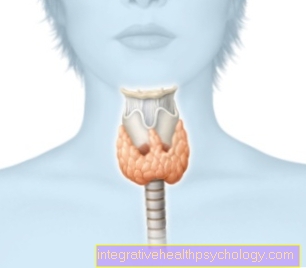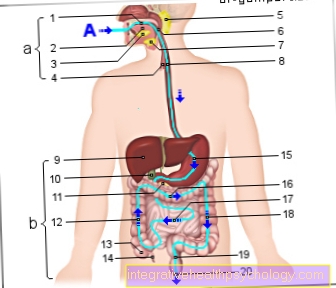Calcified carotid artery
Definition - What is a calcified carotid artery?
Our carotid arteries are often affected and narrowed by calcium deposits with increasing age. There is a common carotid artery that runs from the chest towards the head and divides into an inner and an outer carotid artery in the neck area.
The internal carotid artery, the internal carotid artery, supplies the brain with blood. Calcium deposits very often occur particularly at the branching point of the common carotid artery.
A calcified carotid artery carries the risk of a clot being carried over from the calcified vessel wall into the brain. A stroke can occur and is a dreaded consequence of a calcified carotid artery.

Causes of the calcified carotid artery
The carotid artery calcifies as part of arteriosclerosis. The term arteriosclerosis describes a narrowing of the blood vessels caused by deposits. Risk factors such as old age, high blood pressure and increased blood lipid levels damage the blood vessels over time.
Plaques form (Deposits) on the vessel walls. These deposits are colloquially referred to as lime, so that one speaks of calcified blood vessels.
Are you interested in this topic? You can read more about this in our next article: Can you cure arteriosclerosis?
How are calcified carotid arteries diagnosed?
An ultrasound examination is necessary to diagnose calcification of the carotid arteries. With the ultrasound device you can examine the neck vessels quickly and easily and assess the blood flow in the vessels. An ultrasound examination of the neck vessels is one of the stroke prevention examinations.
What do you see in the ultrasound?
The ultrasound device enables the vessel walls to be examined to a tenth of a millimeter. The intima media thickness is measured, i.e. certain layers of the vessel wall of the main artery. If you can see a thickened wall section in the ultrasound, this is a sign of an existing arteriosclerosis.
In addition to the wall thickness, modern ultrasound devices can make plaques visible. Even tiny deposits on the vessel walls can be detected.
Furthermore, a vessel constriction (Stenosis), caused by deposits and changes in the vessel walls, to a change in the blood flow. Ultrasound machines have techniques that depict the flow of blood.
Are you interested in this topic? Then read our next article on this below: Ultrasound
I recognize a calcified carotid artery from these symptoms
Mild and moderate calcifications of the carotid artery usually cause no symptoms at all for a long time. The clinical picture is called asymptomatic carotid stenosis.
Severe narrowing of the carotid artery can cause serious symptoms. These include visual disturbances, speech disorders, symptoms of paralysis in the arms and / or legs, headaches and dizziness. All of these symptoms are signs of impaired blood flow to the brain.
People may also feel pain around their carotid arteries. In addition, if the carotid artery is calcified, there is always a risk of a stroke.
Pain in the carotid artery
Carotid artery pain is a non-specific symptom that can be attributed to various causes.One possible cause is muscle tension, which can be treated well with physiotherapy and warmth.
Carotidynia (Fay syndrome) Cause pain in the carotid artery. It is a radiating pain in the area of the carotid artery that is triggered by pressure on the carotid artery.
A narrowing of the carotid artery due to calcium deposits and a carotid dissection, a splitting of the wall layers of the carotid, are serious clinical pictures that can cause pain in this area and require treatment.
Are you more interested in this topic? You can read more about this in our next article: Carotid artery hurts - what to do?
Therapy of calcified carotid arteries
Calcified carotid arteries require therapy to prevent a stroke. In the case of mild to moderate stenoses of the carotid artery in particular, a lifestyle change is the primary treatment goal. Sufficient exercise, a balanced diet, quitting smoking and good blood sugar control can slow down further vascular calcification.
In addition, blood-thinning medication is often prescribed, such as ASA (Acetylsalicylic acid), which prevent clots from forming. Surgery may be necessary if the blood vessels are severely narrowed or if you have suffered a stroke.
For detailed information on this topic, see: Clogged carotid artery - what to do?
When do I need an operation?
Whether an operation is necessary for a calcified carotid artery must be decided on an individual basis. An operation is indicated when patients have already suffered a stroke due to severe carotid artery narrowing or are at high risk of a stroke due to the vascular narrowing.
A severe stenosis of the carotid artery detected with ultrasound and very high blood lipid levels are associated with a high risk of stroke.
These operational options exist
There are two surgical treatment options for a calcified carotid artery.
Carotid endarterectomy has been performed for more than fifty years. During this operation, the carotid artery is surgically widened and calcium deposits are removed. The vessel is then closed again.
Another treatment option is the dilatation of the carotid artery with a balloon and the introduction of a stent or stent to keep the vessel open permanently.
While the carotid endarterectomy is performed openly, through an incision in the neck, the stent insert is inserted through the groin using a catheter.
This is how I eat properly if I have a calcified carotid artery
Since increased blood sugar and blood lipid values have a negative impact on our blood vessels, a balanced diet should be sought in the case of arteriosclerosis.
This means that the amount of alcohol should be reduced and nicotine consumption should be stopped as completely as possible. The carbohydrate intake should be tailored to your needs. Sweets and sugared drinks should be avoided.
The amount of fat should be kept low and care should be taken to consume mostly good fat. Good fats are unsaturated fatty acids found in fish and avocado.
Blood lipid levels should be checked regularly, as cholesterol deposits play a crucial role in vascular calcification.
If you're more interested in this topic, check out our next article below: Healthy eating
Course of disease
A calcified carotid artery can remain asymptomatic and therefore undetected for a long time. Since the calcification typically increases gradually, the risk of a stroke increases as the calcification increases. The risk of a heart attack also increases with calcification of the carotid arteries.
An early change in lifestyle can significantly improve the prognosis for the course of the disease.
These can be the consequences of a calcified carotid artery
Calcification of the carotid artery can cause circulatory disorders. These can only occur briefly at first. Symptoms include dizziness, headache, blurred vision, and temporary paralysis of the arms and / or legs.
The dreaded complication of a calcified carotid artery is the detachment of a clot from the vessel wall. This can block a cerebral vessel and cause a dangerous stroke. In the case of a stroke, the symptoms may persist for a long time or permanently due to the circulatory disorder.
The calcification of the blood vessels can also lead to a heart attack. Carotid stenosis caused by calcium is to be taken seriously and requires treatment in order to prevent serious complications such as a stroke or heart attack.
You may also be interested in this topic: Calcifications in the abdominal artery
Recommendations from the editorial team
Further general information may also be of interest to you:
- Therapy of circulatory disorders
- Clogged carotid artery - what to do?
- Therapy of a heart attack
- Calcified heart valve
- Prevent a stroke





























